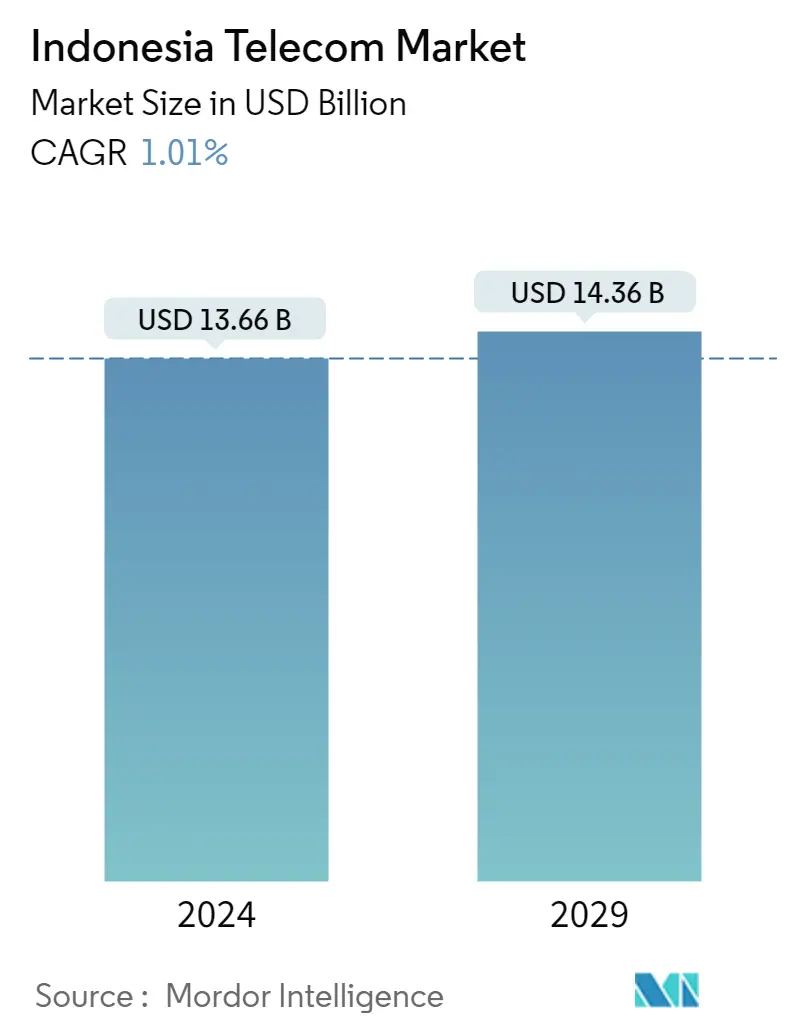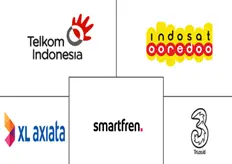Market Size of Indonesia Telecom Industry

| Study Period | 2019 - 2029 |
| Base Year For Estimation | 2023 |
| Market Size (2024) | USD 13.66 Billion |
| Market Size (2029) | USD 14.36 Billion |
| CAGR (2024 - 2029) | 1.01 % |
| Market Concentration | Low |
Major Players
*Disclaimer: Major Players sorted in no particular order |
Need a report that reflects how COVID-19 has impacted this market and its growth?
Indonesia Telecom Market Analysis
The Indonesia Telecom Market size is estimated at USD 13.66 billion in 2024, and is expected to reach USD 14.36 billion by 2029, growing at a CAGR of 1.01% during the forecast period (2024-2029).
The market for telecommunications in Indonesia, which is among the biggest in the world, has plenty of opportunity to expand. The possible increase in users mainly causes this growth. However, it may also be fueled by more revenue per user as the nation's earnings rise.
- The telecommunications sector in Indonesia is one of Asia's fastest-growing industries, with a market worth billions of dollars. The telecommunications business is expected to expand each year steadily as more people move into the digital era. In the second quarter of 2021, this industry contributed IDR 172,39 trillion (USD 1.1 trillion) to the GDP, up by 6.87% over the same period the previous year, according to the study of Badan Pusat Statistik (BPS).
- Furthermore, according to the Bright Indonesia report, the country has 212.4 million internet users and 338.2 million total mobile connections. As a result, mobile operators and the creation of over-the-top (OTT) applications became dominant in Indonesia. The nation's telecommunications network has also been expanding quickly. They are planning to construct 7,904 communication towers with assistance from the government through Bakti.
- Indonesia is collaborating closely with telecommunications providers to support its transformation program. It is anticipated that those dedicated to playing a significant role in the 5G revolution will also get involved in creating telecommunication networks to support tourism initiatives. As per the OpenGov Asia report, the Minister of Communication and Information praised the introduction of 5G telecommunication services as part of the G20 Indonesia Presidency series to assist the realization of the G20 Summit in Bali.
- The present bandwidths granted for 5G to Telkomsel (30 Mhz) and Indosat (20 Mhz) are, however, less than the "ideal" required in the context of the first implementation. A minimum of 80 Mhz to 100 Mhz of the continuous spectrum should be allotted for the initial 5G mid-band, according to a GSMA suggestion. Generally speaking, more smartphone models support the 1.8GHz band that Indosat utilizes for its 5G network than there are for Telkomsel's network (2.3 GHz). Due to a constrained service area and the operator's initial concentration on the B2B sector, it is anticipated that demand for smartphones that support 1.8GHz may increase shortly, but probably not very quickly.
- In Q3 2021, Indonesia's mobile network data traffic increased by 42% year over year to reach 78EB, including traffic from fixed wireless access (FWA) services, according to Ericsson research. In Q3, there was a greater increase in mobile data traffic than ever before the end of 2016. According to recent projections, the total amount of mobile network data traffic is expected to exceed 370 EB by the end of 2027. By the end of 2021, there were 88 million FWA connections. By 2027, there should be over 230 million. It is anticipated that 5G networks will be used to carry about half of these connections.
- The Indonesian telecom market was significantly impacted due to the COVID-19 pandemic. The COVID-19 era in the country has seen the fastest growth in the following mobile app categories: crises, remote working, education/e-learning, and wellness. There had been a noticeable increase in the usage of telecommunication services, resulting in a huge spike in demand. For example, Telkom Group played an important role as the major internet services provider (ISP) in giving the best services during the pandemic. IndiHome, which is a Telkom product, has provided free upgrades in terms of internet connection speed for their users for one month. For students to access their e-learning providers, mobile operators Telkomsel, XL Axiata, and Indosat Ooredoo have provided free internet quotas of 30 GB.
